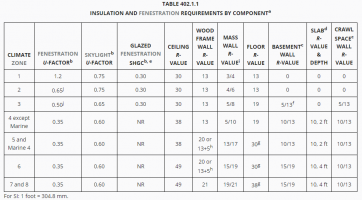Icynene has made this claim for years. They're trying to claim that the reduced air infiltration gives the equivalent higher R-Value. They are in violation of federal law.
In climate zones 5A & 6A we have experienced "raining" in the attic due to moistue migrating through the open cell foam and condensing when it comes in contact with the cold underside of the roof sheathing.
CFR(Code of Federal Regualtions) https://www.ecfr.gov/cgi-bin/retrie...c97a7&ty=HTML&h=L&mc=true&n=pt16.1.460&r=PART
Title 16: Commercial Practices
PART 460—LABELING AND ADVERTISING OF HOME INSULATION
§460.5 R-value tests.
R-value measures resistance to heat flow. R-values given in labels, fact sheets, ads, or other promotional materials must be based on tests done under the methods listed in paragraphs (a) through (d) of this section.
(a) All types of insulation except reflective insulation
must be tested with ASTM C177-13, “Standard Test Method for Steady-State Heat Flux Measurements and Thermal Transmission Properties by Means of the Guarded-Hot-Plate Apparatus;” ASTM C518-17, “Standard Test Method for Steady-State Thermal Transmission Properties by Means of the Heat Flow Meter Apparatus;” ASTM C1363-11, “Standard Test Method for Thermal Performance of Building Materials and Envelope Assemblies by Means of a Hot Box Apparatus” or ASTM C1114-06, “Standard Test Method for Steady-State Thermal Transmission Properties by Means of the Thin-Heater Apparatus.” The tests must be done at a mean temperature of 75 degrees Fahrenheit and with a temperature difference of 50 degrees Fahrenheit plus or minus 10 degrees Fahrenheit.
The tests must be done on the insulation material alone (excluding any airspace). R-values (“thermal resistance”) based upon heat flux measurements according to ASTM C177-13 or ASTM C518-17 must be reported only in accordance with the requirements and restrictions of ASTM C1045-07, “Standard Practice for Calculating Thermal Transmission Properties Under Steady-State Conditions.”

